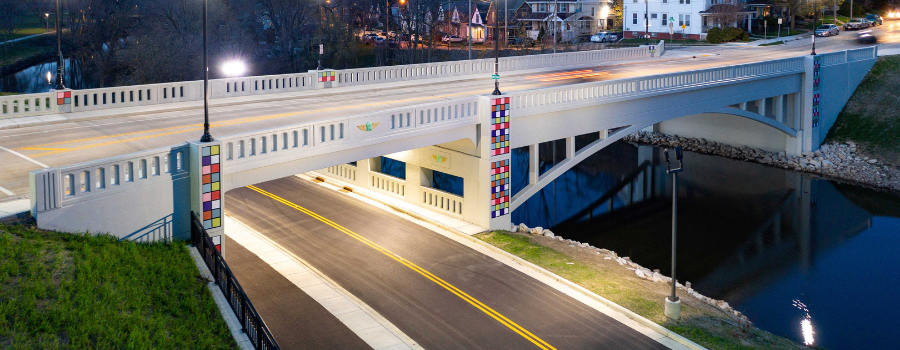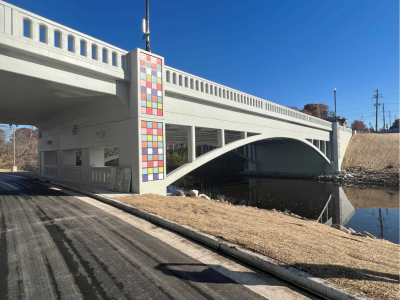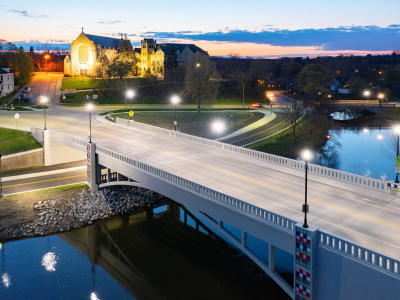Racine’s West 6th Street Bridge Takes History and Makes it Better
 Written by: Dave Pantzlaff, PE, Ayres
Written by: Dave Pantzlaff, PE, Ayres
![]() Replacing a distinctive 94-year-old bridge is a complicated affair. The design for the City of Racine’s West 6th Street Bridge implemented various techniques to reflect history in the modern structure while also accommodating multiple modes of transportation and vastly improving the experience for those traveling along the riverside greenspace under the bridge.
Replacing a distinctive 94-year-old bridge is a complicated affair. The design for the City of Racine’s West 6th Street Bridge implemented various techniques to reflect history in the modern structure while also accommodating multiple modes of transportation and vastly improving the experience for those traveling along the riverside greenspace under the bridge.
 Blending History with Functionality
Blending History with Functionality
The bridge is not only a key link along a busy street, but also a beloved landmark. The 1928 bridge was a 161-foot-long combination open spandrel concrete arch structure. The primary alternative considered for the replacement was a two-span concrete bridge, but incorporating historically inspired aesthetic treatments was important to the City. Decorative elements that resemble the original bridge’s terra cotta and tile mosaic treatments fulfilled this desire, as did arched precast fascia that emulate the early 20th century bridge’s shape.
Innovative Design Techniques
The City contracted with Ayres, which used high-definition scanning to capture the unique features of the existing bridge in measurable digital detail to aid in the new structure’s design. Using this data, an advisory committee consisting of neighborhood groups and various other members of the public, guided the conceptual design features via meetings and a workshop.
 Enhanced Multimodal Accessibility and Scenic River Views
Enhanced Multimodal Accessibility and Scenic River Views
Sidewalks and on-road bicycle accommodations were also incorporated into the project along West 6th Street, whose four-lane motorized traffic pattern was reduced to two lanes to make way for bikes and pedestrians. As part of the bridge replacement, the project also investigated improvements at the intersection of Kinzie Avenue, Horlick Drive, West 6th Street, and Carmel Avenue.
The design didn’t just reshape things for those traveling atop the bridge, but also for motorists, bicyclists, and pedestrians traveling under the bridge along the Root River. The design improved vertical clearance for Horlick Drive as it passes under West 6th Street, and it provided adequate width to accommodate the Root River Pathway for non-motorized travel. The roadway was made safer by increasing the distance between the bridge’s pier and west abutment. The old bridge’s pier had been a solid mass of concrete and blocked out light and the view of the river, but now it is more open to restore natural light and a scenic view.
Public involvement was critical, as the bridge is in a busy section of the City. John Rooney, City of Racine Commissioner of Public Works, stated: “Traffic doesn’t support the need for four lanes. We even received compliments about replacing the unnecessary lanes with bike lanes. Overall, it was a very well-received change.”
The West 6th Street Bridge saw challenges from all sides: City budgets; resident stakeholder needs; environmental considerations like queensnakes, steelhead trout, and indigenous peoples’ burial grounds; detours; and even the removal of an entire building next to the bridge. The design addressed every challenge to make way for a bridge that remains a landmark – and a more functional one at that.
About the Guest Blogger
![]() Dave Pantzlaff, PE, director of Midwest transportation services for Ayres, has been involved in over 1,000 bridge design projects. Dave focuses his more than four decades of structural engineering experience toward understanding what clients need and directing the collective energy of Ayres' respected roadway, structures, and traffic engineers toward solving transportation problems.
Dave Pantzlaff, PE, director of Midwest transportation services for Ayres, has been involved in over 1,000 bridge design projects. Dave focuses his more than four decades of structural engineering experience toward understanding what clients need and directing the collective energy of Ayres' respected roadway, structures, and traffic engineers toward solving transportation problems.
